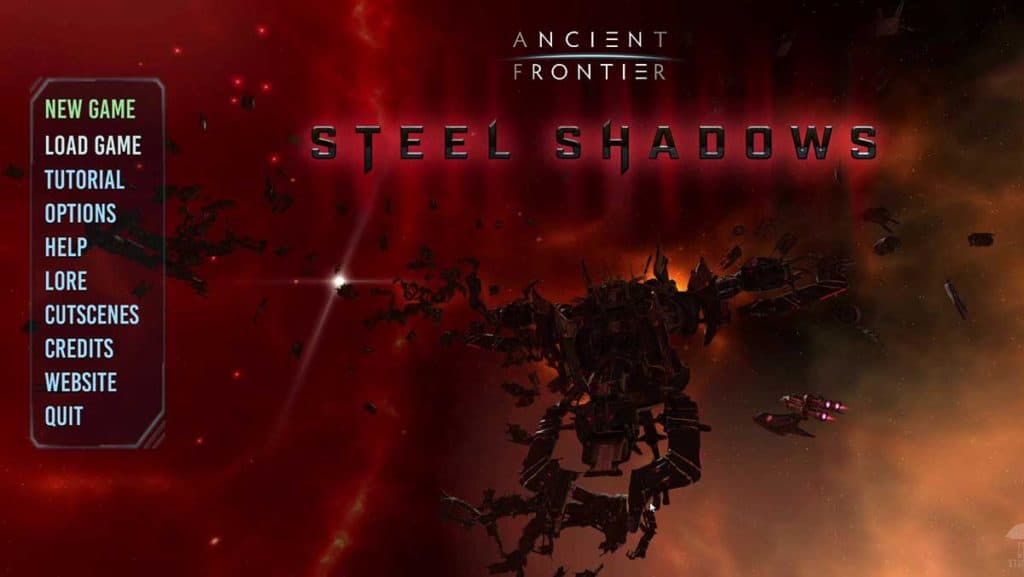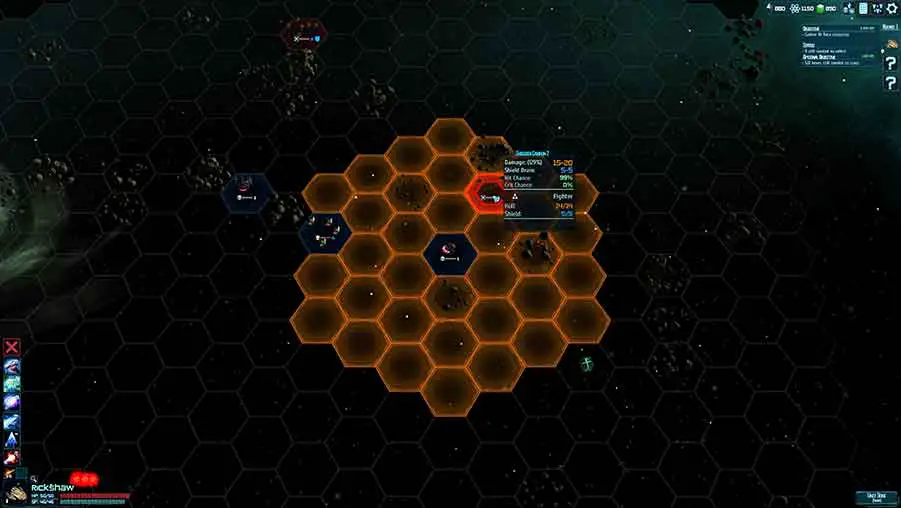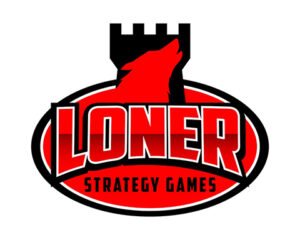
Introduction
Ancient Frontier: Steel Shadows is a turn based tactical game that is heavy on ship-to-ship combat set in the outer fringes of space. This was released on 12/11/2018 and is a stand-alone expansion to the Ancient Frontier PC game. In this game you assume the role of a Pirate taking on the winner of the last war, the Federation.
Steel Shadows focuses on turn-based ship-to-ship combat, upgrading ships between combat missions and getting the best Crew available to staff your ships. This is a game that emphasizes tactical combat and is one that is definitely worth getting if you like tactical space combat.
Entertainment Value
One of the things that makes this game so much fun is that you don’t need get deep into any type of colony management, diplomacy, or empire management. You choose your fleet, arm it, advance it through research, and fight your way through the campaign. A refreshing break from a game that is deep into all these things, like Stellaris or Galactic Civilizations 3, although I enjoy those aspects of a game immensely too. In this game it’s fun just to watch those federation ships blow up.
The graphics are crisp, clear, and well-drawn which make this game enjoyable. On missions the star field in the background is clean and crisp and you have no trouble picking your ship out from the background. Most text and dialog boxes are easy to read although there are a few occasions where the text is small and hard to read, like the mission objectives during combat.
Exploring the sector and wiping out enemy ships while ensuring you don’t land on an asteroid field and obliterate yourself is a lot of fun! There is enough diversity, such as derelict space stations, to keep you from getting bored.
The soundtrack and sound effects are excellent. There are distinctive sound effects for your targeting computer and when activating evasive actions. There is also a very satisfying explosion when you destroy that pesky enemy ship. The soundtrack is engaging and adds to the intensity of the game. The soundtrack definitely pulls you into the game.
Steel Shadows Combat

After the dialog at the start of the game you’ll go into a round of combat. Steel Shadows combat is straightforward but fun and the game is unique in the use of an initiative system. There is a strip of ship icons at the upper right edge of the screen representing your ships and the enemy’s ships. This strip lays out the firing order the ships are in for the round and there are 10 rounds of combat for the missions. Once all 10 rounds are done the mission ends in a failure unless you achieve your objectives before then. The firing order is random, but it is heavily influenced by a ship’s initiative rating, the higher the initiative is the better the chance the ship will fire earlier in the round. Enemies who have not been discovered yet due to the fog of war are represented by a question mark.
Although having a ship with high initiative does not guarantee you’ll be at the top of the stack and get to move and fire first, it does increase the likelihood of being at the top of the stack, which enables you to move and fire sooner than the enemy ships. Firing first is a great advantage to have over an enemy and sometimes finishes the combat before an enemy even has a chance to return fire.
Other “Expresso Shots” you might like:
C&C Remastered, is it worth it?
Terraforming Mars, how good is it?
Each ship has moves and actions. Moves (blue orbs at bottom left of screen) are how may hexes a ship can move and actions (red orbs) are things like firing weapons, boosting shields, activating a targeting computer, etc. You don’t have to use them all at once or in a specific sequence. You can use one set of move points to move in on your enemy, use any firing action points you have and then use your remaining moves to try to get out of your enemy’s weapons range.
When it’s your turn to move the eligible ship is highlighted and all available hexes are highlighted in blue, making it very easy to see what you’re doing. When moving you can go through some obstacles, like asteroids, as long as your turn doesn’t end on one of them. Stopping on a hex with the “danger” popup tooltip will result in damage to your ships.
Planning a move highlights the enemies in red when they’re within range of your weapons. Unfortunately, you can’t get an idea of how effective your weapons fire will be until you have already moved into range. Once you’re in weapons range hovering over an enemy target will bring up an attack tooltip that tells you what weapon you’re using to fire on the enemy, how much damage it will do (sometimes this is a range or numbers), the hit chance and critical hit chance, it’s hull strength and shield strength. If the stats look good, lock and load! Once all ships have moved, fired, or ended their turn, the next round of combat takes place.
One of the neater things with this game is the ability to easily select abilities or to change weapons. There is another strip of icons in the lower left corner that, when clicked on, either activate the ability or a specialized weapons system. When a specialized weapon system is activated it brings up an orange colored grid representing the firing range of the weapon. Pretty easy to use and understand.
During combat missions you also have the opportunity to gain loot, like data or proto energy. These are used for research, purchasing items for ships, or for hiring new crew members. Once an objective is complete, like gathering a certain amount of data, the mission ends, even if enemy ships still remain on the battlefield.
Successfully completing missions unlocks new ship types, gives experience gains to any surviving ships, and provides any rewards that were part of the mission, like proto energy or data. Completing missions can also grant new crew members, give you salvage like escort thrusters that can be installed on a ship. It will also unlock new quests, unlock a new story mission and a new set optional and simulator missions.
Ancient Frontier Steel Shadows Fleet Replenishment
In between missions you get the chance to upgrade and repair fleets using the Fleet menu selection at the left of the screen. Clicking the Fleet tab brings up the fleet screen giving you the chance to install all those ill-gotten gains you salvaged, like escort thrusters. Here you can also get a breakdown on the stats for your ships. The screen is well laid out and gives you all the vital stats for each selected ship, like hull points and how many it has left, shield points, its attacking range, how likely it is to hit a target, etc. It also lists all the abilities the ship has and the background story of the ship if it’s a hero ship.
Fleets
You can select a ship by clicking on its icon in the fleet window. Once selected you can click on the items tab to view what’s already on your ships and items that are available for installation. Items will only fit certain ship types, and some are limited to the equipment slot they can be installed in. Simply drag and drop an equipment icon into a slot to install it. If it can’t be installed the slot border will turn red.
The Crew screen works the same way. Find an available crew member and drag the icon you want to assign the crew member to. If the crew member can’t be assigned the border of the icon for the crew slot will turn red. For instance, a Fighter Ace can only be assigned to a fighter craft. Larger ships will obviously have room for more crew members.
Once your fleets have been replenished and repaired you can go on a mission. There are usually 3 bounty missions to choose from that grant a specific rewards, like Data or Hydrium, or you can take on a simulator mission that gives you additional experience but no rewards. The advantage is that any ship loses incurred during a simulator mission is not permanent.
Market
You can go to the Market, and if you have the funds you can buy better shields and armor and recruit new crew members. In the Fleet section you can purchase ships to replace any loses or, if you’ve done really well, purchase bigger or more agile ships to fight with. As you progress through the game new ships become available as well. You can buy new fighter wings, escort ships and even capital ships.
In the Item section you can get items for your ships like better weapons or shields, just to name a few things, or exchange one resource for another to reduce a shortage, like buy 50 Data points at the cost of 75 Proto Energy. There are similar deals available for all the resources.
The Crew section is where you hire new crew members for your ships. These crew members can usually be assigned only to certain ship types, like fighters, but first you need to recruit them here. They will cost you Proto Energy, Hydrium, and Data, how much depends on how skilled the crew member is. For example, a Pirate Ace is a squadron leader who can only staff fighters. She increases hull points, dodging capability, accuracy, initiative, and critical hit (does double damage) chances by a significant amount, so crew members are certainly worth investing in.
Research
Research is a little tricky if you’re not paying attention. It’s done by ship classes of Fighters, Escorts, Capital ships and Equipment. Equipment is the standard stuff, like Armor and Shield Matrixes. Once improved versions are researched they can be bought at the Market.
Research for each ship class has a separate selection for the type of ship, like an Interceptor, Raider, or Gunship in the Fighter category. Each ship has its own tech tree, so while simple there are still a lot of choices you can make. The ships themselves have two categories of research, Tactical Upgrades, like giving your ship a boost in initiative, or Combat Upgrades, including thruster or shield damage improvements. Conducting research uses up Data.
Quests
Quests pop up occasionally after missions. They’re optional but usually fit right in with your missions and objectives. One of the first ones you’ll get is to research 3 new technologies, once that’s done you gain 50 Proto Energy. Since researching and upgrading is the thing you do between missions this one is a no-brainer, you’ll get it almost automatically.
Missions
Story missions are the main missions. They offer the best rewards and advance the game. Before launching you can look at the threat assessment to decide if you’re ready to take it on or not. If not you can pursue one of the Bounty or Simulator missions to get more resources to improve your ships and crew with.
You will have the option to run a maximum of 3 optional deployments before you have to launch a Story Mission and some of these optional missions will be Bounty missions. These missions allow you to send part or all your fleet on a mission to gain resources and experience. Your hero ships will not always be available for these missions and will stay behind with the main fleet instead. The advantage to only sending part of your fleet is lower deployment costs, which save resources.
Simulator missions are also available. These are harder but ship losses are not permanent. The only thing gained from this deployment type is experience.
Once you launch a mission, you’ll be taken to the Deployment screen. Here you choose which ships to send out if you can afford the deployment cost. Once you’ve selected the ships to send in harm’s way you can launch the mission.
Sometimes at the end of a mission you’ll be offered a choice before returning to your base. You could pick up a distress beacon from a local mining station claiming they have equipment malfunctions and need immediate assistance. You must decide whether to help them, ignore them thinking it might be a trick, or be a typical pirate and take advantage of the situation by attacking them and stealing what resources they have. In this particular scenario I chose to help and was rewarded with 300 Proto Energy. These are not actual missions, they are text-based decisions with both gains and penalties that don’t have to be played out with actual combat or movement to the systems.
The mission length is just right for this game and is typically limited to ten rounds, meaning each surviving ship gets ten chances to move, fire, etc. It will be shorter than 10 rounds if you complete all the objectives in your mission.
Tutorial
The tutorial is 16 minutes long and walks you through the game basics like how to equip ships, combat, collecting resources, research, and explains exactly what missions are. It’s a copy form the original Ancient Frontier game so there are a few omissions and inaccuracies, like calling the Market the Store, plus there is no mention of the Crew, but once you learn the basics you’ll have no problem working with the crew or the game. It’s worth the time it takes to get a good understanding of how the game works. It is not interactive so that may be a drawback to some players.
User Interface
The game’s user interface lets you easily choose whether you want to look at your fleet, go to the market to buy more ships, equipment, or hire more crew members for your fleet and select missions. By hovering over the icon of the ship you are thinking of buying you get a readout of the types of weapons the ship has and what type of combat it is best suited for, like anti-fighter.
Game AI
The AI is good and has a logic of its own. I sometimes don’t understand its logic, but it still manages to beat me enough times that it must make sense if you’re a computer. There are three difficulty levels for this game, beginner, veteran, and epic.
Stability and Replay Value
This is a stable game. The game load/save system is somewhat different from other games but is still efficient and user friendly. When starting a new game, you choose a save slot and all future progress is saved in that slot. There are five save slots to choose from, which means you can play and save five different versions of the in-process game. Clicking on the load button brings up five choices. You can either load the last save or choose from one of four backups. Saving is simple, just bring up the game menu and click the save game option.
This game has limited replay value since the story is mostly linear. The choices and quests make for a good diversion but overall, once you’ve played the game through a few times, you’ll grow tired of it.
Conclusion
This a very solid, good game. I have only a few complaints that are vastly outweighed by all the good aspects I enjoyed while playing the game. One of my biggest concerns is that a few of the text-based dialogs and menus are sometime too small to easily read, but for the most part that is not a problem on the majority of the menus.
The only thing I found limiting was the replay factor. It really depends on what you’re looking for, but I still think I got my “bang for the buck” when I bought this game since it offered combat without worrying about any empire building or diplomacy. I enjoy those aspects in other games, but sometimes I’m just looking for a break from all the intense brain exercise and want something where I can just fight it out with an enemy. This game fulfills that desire.
I really enjoy the ability to buy ships and improve them, and I especially enjoy the combat sequences. Sometimes waiting for my turn in the random order of things was almost too much to bear! If you like strategy games in a space setting, that crosses Sid Meir’s spaceships with an xComish feel to the game, then this is a good one for you!
Don’t forget to visit my YouTube channel at https://www.youtube.com/channel/UCcWU6qxVisK93h5guKRVtdg
Do you like space strategy games? Take a look at our sections on Stellaris and Sins of a Solar Empire: Rebellion.

